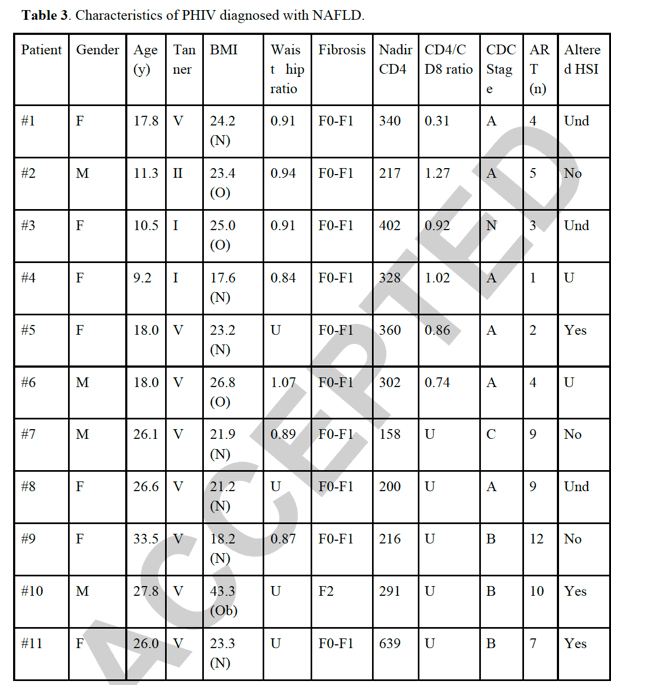| |
Fatty Liver (NAFLD) in HIV+ Young, Children, Adolescents
|
| |
| |
Download the PDF here
The prevalence of NAFLD was high (28.9%) among PHIV, and only partially explained by overweight and metabolic syndrome defining factors.
By means of non-invasive imaging techniques, a total of 11 PHIV participants were diagnosed with steatosis, vs. only three of the HIV-negative controls (28.9% vs. 7.9%; p=0.02).
In this exploratory study using non-invasive imaging techniques, the prevalence of NAFLD among youths living with HIV since childhood was surprisingly high (28.9%) compared to an uninfected cohort. The fact that no clear relation to overwei ght and the metabolic syndrome defining factors could be estab lished, together with the extremely poor performance of the scores based on clinical and analytical parameters, are worrisome, as identification of patients at risk remains extremely challenging among youths.
Clinicians should be aware of th e risk and consider the need for screening. According to our results, the performance of scores based on clinical and analytical parameters for the identification of patients at risk is poor among youths.
----------------------

Jan 2022
Carrasco, Itzíara; Olveira, Antoniob; Lancharro, Ángelc; Escosa, Luisd; Mellado, María Josée; Busca, Carmenf; Montes, María Luisag; Diez, Cristinah; Alcolea, Soniai; Navarro, María Luisaj; Sainz, Talíak
Abstract
Objective:
The prevalence of subclinical liver abnormalities is high among people living with HIV, but data regarding perinatally HIV-infected children and adolescents (PHIV) are scarce. Non-invasive image techniques offer an opportunity to address non-alcoholic fatty liver disease (NAFLD) in a population in which the scores validated for adults have not been tested.
Design:
Prospective cross-sectional study including PHIV and uninfected controls.
Methods:
Non-invasive imaging techniques for the diagnosis of NAFLD and/or fibrosis were performed, and four scores to predict NAFLD were evaluated.
Results:
Seventy-six participants (59.2% women) with a median of 19 years old (IQR: 15.5–25.6) were included, 38 were PHIV and 38 were age and sex-matched controls. All HIV participants were on ART at the moment of inclusion, and 86.8% were virologically suppressed. A total of 11 PHIV and three controls were diagnosed with NAFLD (28.9% vs. 7.9%; p = 0.02) by non-invasive imaging techniques. The performance of scores based on clinical and analytical parameters was very poor. Although non-significant, overweight was more common among participants with NAFLD, who had a significantly higher BMI. Differences in HIV-related parameters between the groups were non-significant, except for the CD4/CD8+ T-cells ratio, decreased among PHIV diagnosed with NAFLD (p = 0.04).
Conclusions:
The prevalence of NAFLD was high (28.9%) among PHIV, and only partially explained by overweight and metabolic syndrome defining factors. The scores based on clinical and analytical parameters did not accurately identify subjects at risk. Therefore, liver ultrasound assessment should be considered for the screening of NAFLD among PHIV in routine clinical practice.

|
|
| |
| |
|
|
|